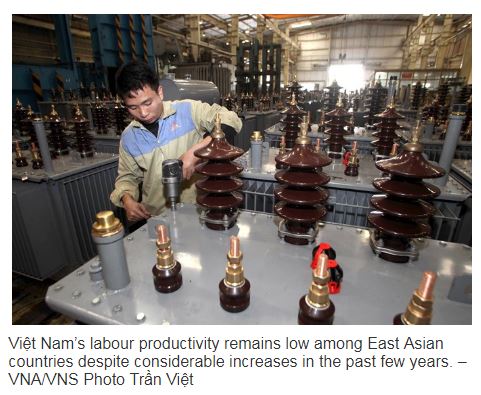Vietnam’s labour productivity among lowest in region
HÀ NỘI – Despite having increased at a relatively fast pace in recent years, Việt Nam’s labour productivity remained in the lowest group in East Asia with scores in backbone sectors of the economy even falling behind Cambodia, a report found on Tuesday.
The Việt Nam Annual Economic Report this year, conducted by the Việt Nam Institute for Economic and Policy Research (VEPR), focused on the development of the country’s labour market and policy recommendations to enhance low labour productivity and the quality of human capital.
According to the report, labour productivity for the whole economy was improving at quite a high rate, at about 22.5 per cent between 2008 and 2016. But a closer look tells a more worrying story.
A comparison with Northeast Asian countries of Japan, South Korea and China and member nations of the ASEAN bloc, including Singapore, Thailand, Malaysia, the Philippines, Indonesia and Cambodia, shows that the labour productivity of Việt Nam’s nine industries in 2015 barely made it out of the bottom group. It was, in fact, the lowest among all in three particular sectors: manufacturing; construction; and transportation, storage and communications.
Việt Nam’s performance was slightly better, to rank second lowest – only higher than Cambodia – in agriculture; electricity, water and gas; and wholesale, retail and repair.
“Việt Nam’s labour productivity was the lowest in the most important sectors of an economy. That’s very concerning,” said VEPR President Dr Nguyễn Đức Thành.
Wage and productivity
Tuesday’s report also shed some light on the link between the constant rise of minimum and average wage and labour productivity.
As it turns out, during the 2004-2015 period, Việt Nam’s average wage growth at 6.7 per cent generally outstripped labour productivity growth which stood at five per cent.
“In principle, wage growth should go in line with labour productivity growth to help stably maintain a company’s profit. If the wage outgrows productivity, it will hinder the accumulation of human capital, reduce the motivation of investors, profits of enterprises and competitiveness of the economy,” Thành said.
According to the report, Vietnamese’s average real wage doubled between 2004 and 2015, which included increasing payments on social, health, and unemployment insurance.
A quick comparison to Việt Nam’s neighbours shows that the minimum cost per Vietnamese worker, comprising the minimum wage and contributions to social security that an employer had to pay in 2017 was just a few dollars lower than that of Thai workers and slightly higher than in Indonesia. It was notable, however, that Vietnamese employers had to pay a much bigger share for social security than those in Thailand or Indonesia, which led to a bigger burden on them.
“Increasing wage growth and also a hike in the costs for workers will eventually diminish Việt Nam’s cheap labour cost advantage,” said Dr Nguyễn Thị Lan Hương, former director of the Institute of Labour Science and Social Affairs. – VNS
http://vietnamnews.vn/economy/427618/vietnams-labour-productivity-among-lowest-in-region.html#x21BTK385DxFF609.99


 English
English




